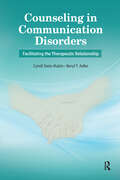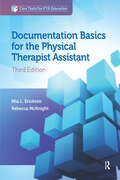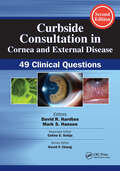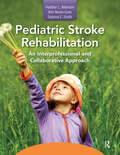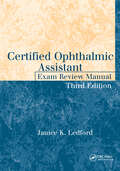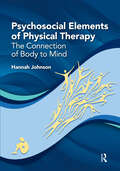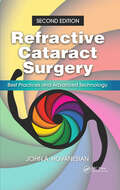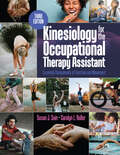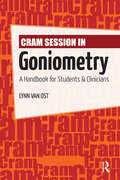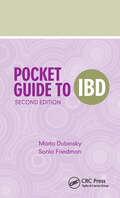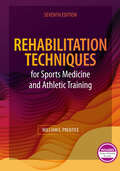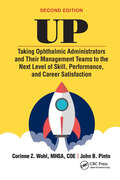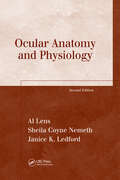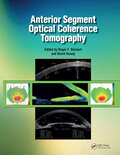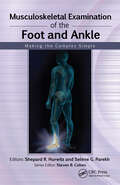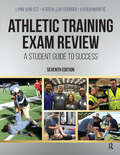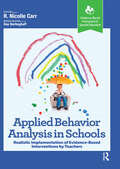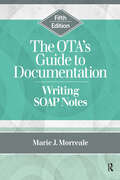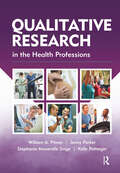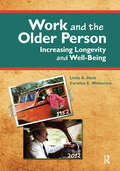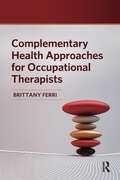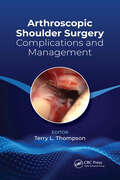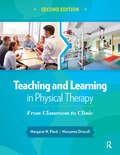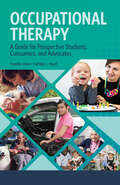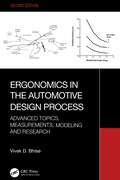- Table View
- List View
Counseling in Communication Disorders: Facilitating the Therapeutic Relationship
by Cyndi Stein-Rubin Beryl AdlerIncorporating a counseling paradigm has been shown to increase motivation, deepen learning, and sustain progress for clients and families. Counseling in Communication Disorders: Facilitating the Therapeutic Relationship by Cyndi Stein-Rubin and Beryl T. Adler, is an engaging textbook, written in a genuine and lively tone, so that the reader may easily relate to the material. The text provides a practical vehicle for speech-language pathology students, clinicians, clinical supervisors, and instructors to get to know themselves better and to integrate basic counseling attitudes and tools into their diagnostic and therapeutic programs. Inside Counseling in Communication Disorders, Stein-Rubin and Adler describe the importance of addressing a client’s communication challenges by working with the whole person, as a human being, not as a communication disorder. By approaching clients with a counseling attitude that encourages the client’s full participation in the treatment process, we then work together in partnership and as a powerful team. The content, techniques, and exercises within Counseling in Communication Disorders are rooted in evidence-based practice from a variety of psychological, counseling, and coaching approaches, such as Humanistic Counseling, Listening and Language, Narrative Therapy, The Cognitive Behavioral Model (CBT), Solution-Focused Brief Therapy (SFBT), Positive Psychology, Neurolinguistic Programming (NLP), and Mindfulness training.Counseling in Communication Disorders also includes reflective questions, exercises, and suggestions to reinforce important concepts. To bring the content to life, real-life and clinical scenarios are interspersed throughout the text.It is well understood that speech-language pathology and audiology clinicians must understand deep listening and how to choose words that will have a positive impact on their client and families, but often overlooked is the personal development of the clinicians themselves. Counseling in Communication Disorders is a comprehensive guide on how to provide the necessary support and encouragement to clients and build self-esteem, while a major focus is the need for the clinicians to work on self before working on other. Counseling in Communication Disorders: Facilitating the Therapeutic Relationship is the first textbook of its kind to comprehensively cover both sides of the therapeutic relationship. Students and clinicians alike will appreciate this unique approach that addresses not only the counseling attitude that is vital to the growth and progress of clients, but also the self-awareness that guides the personal development of the clinician.Included with the text are online supplemental materials for faculty use in the classroom.
Documentation Basics for the Physical Therapist Assistant (Core Texts for PTA Education)
by Mia Erickson Rebecca McKnightComplete and accurate documentation is one of the most important skills for a physical therapist assistant to develop and use effectively. The new Third Edition of Documentation Basics for the Physical Therapist Assistant continues the path of teaching the student and clinician documentation from A to Z. Mia Erickson and Rebecca McKnight have updated this Third Edition to reflect changes in the ever-evolving profession. Newly addressed are the changes in documentation requirements for major payers, changes in the disablement models used, and the increasingly common use of electronic documentation in the physical therapy profession. Features inside the Third Edition: Readers are encouraged to think about disablement and disablement concepts when writing notes How to document impairments in body structure and function but more importantly activity limitations and participation restriction Descriptions of the differences in documentation methods using a computer vs paper chart Evidence tied to benefits and challenges of computerized documentation Documenting the rationale for treatment and the unique skills of the physical therapist assistant in patient management New inside the Third Edition: Incorporation of the International Classification of Functioning, Disability, and Health disablement model Chapter on electronic documentation Screenshot examples of the popular WebPT® electronic medical record platform Updated chapters on reimbursement and legal issues Additional examples for student practice included in each chapter Included with the text are online supplemental materials for faculty use in the classroom. Documentation Basics for the Physical Therapist Assistant, Third Edition is the perfect guide for all physical therapist assistant students and clinicians who want to update and refine their knowledge and skills in documentation.
Curbside Consultation in Cornea and External Disease: 49 Clinical Questions (Curbside Consultation in Ophthalmology)
by Mark Hansen David R. Hardten Celine SatijaCurbside Consultation in Cornea and External Disease, Second Edition contains new questions and brief, practical, evidence-based answers to the most frequently asked questions that are posed during a “curbside consultation” between clinicians. Dr. David R. Hardten and associate editors Drs. Mark S. Hansen and Celine Satija have designed this unique reference in which cornea and external disease specialists offer expert advice, preferences, and opinions on tough clinical questions commonly encountered by corneal specialists, ophthalmologists, or residents. The unique Q&A format provides quick access to current information with the simplicity of a conversation between two colleagues. Numerous images, diagrams, and references are included to enhance the text and illustrate clinical diagnoses and treatment plans. Some of the questions that are answered inside the Second Edition include: I have a patient with Fuchs' Endothelial Dystrophy. Is there anything new to improve her vision? What should I do with a young patient with mild keratoconus? How can I help a 47-year-old female who uses artificial tears 6 times daily and continues to complain of dry eyes? A patient presents with corneal ulcer. What work-up and treatment would you recommend? How do I manage a patient that rubbed their eye just after LASIK? What could go wrong? What can I offer a patient that sustained eye trauma and loss of iris tissue? I have a patient with poor vision after DMEK. What went wrong and how do I get better vision for them? Curbside Consultation in Cornea and External Disease: 49 Clinical Questions, Second Edition provides information basic enough for residents while also incorporating expert pearls that even high-volume ophthalmologists will appreciate. Cornea specialists, general ophthalmologists, and residents alike will enjoy the user-friendly and casual format and the expert advice contained within.
Pediatric Stroke Rehabilitation: An Interprofessional and Collaborative Approach
by Sabrina Smith Heather Atkinson Kim Nixon-CavePediatric Stroke Rehabilitation: An Interprofessional and Collaborative Approach is a groundbreaking text designed to enhance the practice of all health care providers, enrich discussion, and emphasize the interdisciplinary nature of managing best outcomes for a child who has had a stroke. Evidence-based practice is threaded throughout the text with an emphasis on recovery vs. compensation, goal achievement, and outcome measurement.In conjunction with the interdisciplinary contributions from a wide variety of health care professionals, Drs. Heather Atkinson, Kim Nixon-Cave, and Sabrina E. Smith aim to provide the necessary tools to effectively treat children with stroke.The first section reviews the medical fundamentals, covering all major types of strokes. The second section of Pediatric Stroke Rehabilitation focuses on the core of the matter, rehabilitation. The final section expands the understanding of the child’s recovery to the family, community, and school environment.Select chapters include: Personal vignettes written by family members of children who have had a stroke that provides insight into the impact a stroke can have on the child and family A family focus box to summarize the main points of the chapter to provide the best tools for caregivers to advocate for their child A case study related to the content and family perspective Pediatric Stroke Rehabilitation also utilizes the World Health Organization’s International Classification of Functioning, Disability, and Health (ICF) framework throughout.Included with the text are online supplemental materials for faculty use in the classroom.Pediatric Stroke Rehabilitation: An Interprofessional and Collaborative Approach is an interdisciplinary and invaluable resource for students and clinicians to understand and apply effective evidence-based practice and treatment approaches for childhood stroke. The text will also be of interest to healthcare professionals, specifically physical therapists, occupational therapists, speech-language pathologists, physicians, neuropsychologists, nurses, and educators, who work with children who have experienced a stroke.
Certified Ophthalmic Assistant Exam Review Manual (The Basic Bookshelf for Eyecare Professionals)
by Janice K. LedfordThe best-selling exam preparation manual for more than 15 years has been extensively updated into a Third Edition. With revisions and additional material that match the new JCAHPO® criteria for Certified Ophthalmic Assistants (COA®), this study resource will remain the top choice for those studying for certification. With nearly 1,400 questions, the Certified Ophthalmic Assistant Exam Review Manual, Third Edition contains more questions with explanatory answers than any other study aid. Additionally, all 19 exam criteria headings are covered inside, including history taking, visual assessment, medical ethics, pharmacology, ophthalmic imaging, surgery, and more. Features:• Study tips, hints, and test-taking strategies• Explanatory answers for every question• Updated to reflect new JCAHPO COA exam criteriaCertified Ophthalmic Assistant Exam Review Manual, Third Edition by Janice K. Ledford will be the most talked-about resource for those studying for the COA® exam, students in ophthalmic and optometric assisting programs, and those who wish to review before taking the COT® exam.
Psychosocial Elements of Physical Therapy: The Connection of Body to Mind
by Hannah JohnsonPhysical therapists know that their patients are more than just a list of symptoms. They are people first, often with a complex mix of medical and psychiatric circumstances, who may receive a wide range of care from a team of professionals. Keeping this in mind, Psychosocial Elements of Physical Therapy: The Connection of Body to Mind is both a textbook and a clinical resource for physical therapist students and clinicians practicing in any patient population with psychological concerns or disorders.Inside, Dr. Hannah Johnson provides an essential introduction of psychosocial concepts, general treatment approaches for culturally sensitive care, and selected classes of mental illness as defined by the Diagnostic and Statistical Manual of Mental Disorders, 5th Edition (DSM-5). A complete review of the current research and evidence base provides students a strong foundation to build their careers on, but can also act as a crash-course in the most recent literature for the busy clinician.Features: Clear, concise language and layout for efficient learning Application-based review questions Real world case studies to apply critical thinking skills Evidence-based practical tests and measures Vocabulary terms that facilitate interdisciplinary teamwork Psychosocial Elements of Physical Therapy: The Connection of Body to Mind provides physical therapist students and clinicians with an efficient yet comprehensive guide to helping patients with psychological concerns or disorders.
Refractive Cataract Surgery: Best Practices and Advanced Technology
by John HovanesianUpdated and expanded, this Second Edition of Refractive Cataract Surgery: Best Practices and Advanced Technology is a practical guide for cataract surgeons and general ophthalmologists who wish to take their practices to a new level by offering refractive solutions to their cataract patients. All chapters have been updated to provide the latest information on premium surgery, including how-to chapters on extended depth-of-focus implants, intraoperative aberrometry, and femtosecond laser surgery. Both well-established and cutting-edge implants and techniques are presented in chapters that are organized by topic and detailed step-by-step. Dr. John A. Hovanesian and his contributors include enhancement strategies such as piggyback lenses, laser enhancement, and incisional surgery which are presented as separate and complete solutions. In addition to surgical strategies, Refractive Cataract Surgery, Second Edition explains the psychology of creating a premium practice. Non-technical matters such as patient screening, ethics, communicating the value of lenses, and managing the unhappy patient are thoroughly presented with easy-to-adopt ideas. New in the Second Edition: Intraoperative aberrometry Femtosecond laser cataract surgery Diagnostic and management tools for ocular surface disease Extended depth-of-focus implants Updated information on Tecnis toric, Trulign, and other accommodating IOLs Advice on various pricing models Refractive Cataract Surgery: Best Practices and Advanced Technology, Second Edition explores every angle of premium surgery and practice and offers improvements for all levels of surgeons, from the resident to the experienced physician, resulting in a top experience and a lifetime of premium vision for the patient.
Kinesiology for the Occupational Therapy Assistant: Essential Components of Function and Movement
by Susan Sain Carolyn RollerThe only kinesiology book written by occupational therapy practitioners for the occupational therapy assistant is back with the Third Edition.Kinesiology for the Occupational Therapy Assistant: Essential Components of Function and Movement, Third Edition approaches the study of kinesiology by connecting function to the underlying components that make movement possible.This text uses a top-down approach to showcase the functional level of a client and then guides the reader to ascertain what fundamental kinesiological functions may be causing limitations or decreased engagement in daily activities. Occupational profiles introduce occupational therapy assistant students to real-life patients and describe occupational therapy treatment and patient outcomes. The reader will gain insight into the practice of occupational therapy through solving problems and developing questions needed to assist the client to achieve movement-related goals in tasks, activities, and occupations.What’s included in the Third Edition:• Updates to reflect AOTA’s model curricula for basic sciences and the OTPF-4. • Chapters on kinesiology and therapeutic exercise as well as functional mobility in the home and community.• Emphasis on function and identification of how and why movement occurs.• Select standardized tests, pinch and grip strength, and range of motion norms are noted where appropriate.Included with the text are online supplemental materials for faculty use in the classroom.Kinesiology for the Occupational Therapy Assistant: Essential Components of Function and Movement, Third Edition is a one-of-a-kind text that will enable occupational therapy assistant students to identify the underlying components that make movement possible.
Cram Session in Goniometry: A Handbook for Students and Clinicians
by Lynn Van OstWhen all you need is a basic understanding of goniometry. When concise and illustrative examples of goniometric techniques will provide exactly what the rehabilitation professional needs—Look to Cram Session in Goniometry: A Handbook for Students and Clinicians for quick and “at your fingertips” facts.Cram Session in Goniometry by Lynn Van Ost is a concise and abundantly illustrated quick reference which provides the rehabilitation professional with a very basic approach to various goniometric techniques. Organized in a “head to toe” format, Cram Session in Goniometry takes user-friendly and efficient learning to a new level.What is in your “Cram Session”:• Photographs depicting each goniometric measurement• Breakdown of each body region covered• Each type of joint, capsular pattern, average range of motion, patient positioning, goniometric alignment, patient substitutions, and alternative methods of measurement• Over 190 photographsCram Session in Goniometry: A Handbook for Students and Clinicians is an informative, well-organized handbook for all students and clinicians in physical therapy, occupational therapy, athletic training and orthopedics.
Pocket Guide to IBD
by Sonia Friedman Marla DubinskyPocket Guide to IBD, Second Edition is designed to provide quick clinical information for gastroenterologists, primary care physicians, physician assistants, and nurse practitioners who need to review symptoms, medications, and disease management, in order to decide effective diagnoses and treatments for their patients with IBD.Some of the topics covered are:• Special populations, including pregnancy and children• Vaccinations in the patient with IBD• Treatment of the infliximab refractory patient• Diagnosis and treatment of perianal disease• Care of the post operative patientDr. Marla Dubinsky and Dr. Sonia Friedman have created this go-to reference for one of the most popular topics among practicing gastroenterologists and other GI and primary care providers.Features:• Comprehensive chapters in quick reference format• Symptom-based guide for diagnosis and treatment • Tables highlighting the full array of IBD medications • Charts and figures detailing complete treatment algorithmsThe Pocket Guide to IBD, Second Edition is unique in its size, accessibility of information, thoroughness, and clarity of content. This clinical guide will be the quick reference to turn to when treating patients with IBD.
Rehabilitation Techniques for Sports Medicine and Athletic Training
by William PrenticeRehabilitation Techniques for Sports Medicine and Athletic Training, Seventh Edition is the definitive reference for athletic training students and professionals who are interested in gaining more in-depth exposure to the theory and practical application of rehabilitation techniques used in a sports medicine environment.Dr. William Prentice and his contributors have combined their knowledge and expertise to produce a single text that encompasses all aspects of sports medicine rehabilitation. Featuring more than 1,000 full-color illustrations, 700 high-resolution videos, and an integrated laboratory manual, this newly updated Seventh Edition provides the athletic trainer with a complete guide to the design, implementation, and supervision of rehabilitation programs for sport-related injuries.The Seventh Edition includes new and updated information on topics including:• Pharmacology and the role of medication in pain management and performance• Nutrition and its impact on rehabilitation• Rehabilitation techniques for the core • Roles within the rehabilitation team• Pathomechanics and epidemiology of common injuries• Psychological considerations and communication with injured patients• Tips for documentation from Dr. Prentice Included with the text are online supplemental materials for faculty use in the classroom.Rehabilitation Techniques for Sports Medicine and Athletic Training, Seventh Editionis a comprehensive resource for athletic training students, faculty, and clinicians; physical therapists who manage rehabilitation programs for sports-related injuries; as well as for strength and conditioning coaches who supervise performance enhancement programs on return to play.
UP: Taking Ophthalmic Administrators and Their Management Teams to the Next Level of Skill, Performance and Career Satisfaction
by John B. Pinto Corinne WohlLike having an expert mentor in your pocket, UP is a powerful, practical workbook designed to take ophthalmic administrators and practice managers to the next level of their careers, offering practical tips, concrete advice, and a step-by-step guide for any hurdle they face. Authors Corinne Wohl and John Pinto are undisputed experts in the field, having decades of experience advising ophthalmic practices of all sizes and publishing numerous books and articles on the subject. In this book, Wohl and Pinto guide administrators toward best practices in coaching and developing their entire management team. UP is also a helpful tool for physician leaders (and leaders in training), who can only accomplish their board-level goals through effective lay managers.UP provides readers with: Practical tips on how to create a customized support and development program for each manager and administrator A step-by-step process for better problem solving Worksheets, insightful self-tests, and scorecards for immediate use as part of a linear career development program
Ocular Anatomy and Physiology (The Basic Bookshelf for Eyecare Professionals)
by Janice K. Ledford Al Lens Sheila Coyne NemethUpdated to include new material for beginners in ophthalmology and optometry, Ocular Anatomy and Physiology, Second Edition is an essential text that covers a range of fundamental information for students and clinicians. With collaborations from Al Lens, Sheila Coyne Nemeth, and Janice K. Ledford, Ocular Anatomy and Physiology, Second Edition now begins with a jump-start chapter to overview the topic for those new to the field of eye care. Chapter two delves into embryology—a topic rarely covered—and addresses each structure of the eye, including the bony orbit, eyebrows, eye lids, lacrimal system, extraocular muscles, and the globe. While the text continues to emphasize normal anatomy, each chapter contains a glossary of common disorders. Also included is a description of diagnostic methods for examining various tissues. The physiology of various structures and systems is explained, including the visual pathway, the inflammatory response, immunology, binocular vision, refractive errors, and accommodation. To enhance the reader’s understanding of each topic, illustrations are provided.Features of the Second Edition: New jump-start chapter for beginners Details on diagnostic methods for each structure or segment, including optical coherence tomography and retinal thickness analysis Glossary of common disorders at the end of each chapter With new features and information, Ocular Anatomy and Physiology, Second Edition is a valuable text for ophthalmic and optometric assistants, training facilities, and practices, as well as beginners in the field of eye care, including sales representatives and pre-med students.
Anterior Segment Optical Coherence Tomography
by David Huang Roger SteinertHigh-speed anterior segment optical coherence tomography (OCT) offers a non-contact method for high resolution cross-sectional and three-dimensional imaging of the cornea and the anterior segment of the eye. As the first text completely devoted to this topic, Anterior Segment Optical Coherence Tomography comprehensively explains both the scientific principles and the clinical applications of this exciting and advancing technology.Anterior Segment Optical Coherence Tomography enhances surgical planning and postoperative care for a variety of anterior segment applications by expertly explaining how abnormalities in the anterior chamber angle, cornea, iris, and lens can be identified and evaluated using the Visante OCT™.Inside Anterior Segment Optical Coherence Tomography, Dr. Roger Steinert and Dr. David Huang, along with 22 of the field's leading professionals, provide a wealth of useful clinical and physiological material about this new diagnostic imaging technique. Valuable images are included to assist in the pre- and postoperative assessment of various anterior segment disorders. Additionally, this unique resource contains detailed information on biometric measurements to enhance diagnostic capability.On the leading edge of anterior segment imaging: Mapping of corneal thickness and keratoconus evaluation Measurement of LASIK flap and stromal bed thickness Visualization and measurement of anterior chamber angle and diagnosis of narrow angle glaucoma Measuring the dimensions of the anterior chamber and assessing the fit of intraocular lens implants Visualizing and measuring the results of corneal implants and lamellar procedures Imaging through corneal opacity to see internal eye structures With the increase in popularity of anterior chamber imaging, and anterior segment OCT proving to be the best tool for high resolution biometry, Anterior Segment Optical Coherence Tomography is a must-have for anterior segment, refractive, cornea, and glaucoma surgeons.
Musculoskeletal Examination of the Foot and Ankle: Making the Complex Simple
by Shepard Hurwitz Selene ParekhThe physical examination of the foot and ankle can be a complex topic for professionals with all levels of clinical experience. How can advance concepts be taught in a user-friendly, clear format, while still providing necessary information for effective diagnosis and treatment of the foot and ankle?Musculoskeletal Examination of the Foot and Ankle: Making the Complex Simple by Drs. Shepard Hurwitz and Selene Parekh answers these questions. Written by experts, this easy-to-carry book provides a quick and thorough review of the most common pathologic foot and ankle conditions, techniques for diagnosis, as well as the appropriate treatment for each condition.Musculoskeletal Examination of the Foot and Ankle: Making the Complex Simple contains clear photographic demonstrations, tables, sidebars, and charts throughout its pages, allowing a thorough and concise examination of the foot and ankle.A glance at some of what is covered inside:• Physical Examinationo Basics and specific tests of the foot and ankle• General Imagingo Basic interpretation of common imaging modalities of the foot and ankle• Common Conditionso Bunions, toe deformities, Achilles pathology and posterior calcaneal pain, fractures, plantar fasciitis and plantar heel pain, and moreMusculoskeletal Examination of the Foot and Ankle: Making the Complex Simple contains essential information to successfully take a complex subject, and bring it to a level that will be welcomed by orthopedic residents, faculty, physical therapists, athletic trainers, medical students interested in musculoskeletal health careers, and other health care providers.
Athletic Training Exam Review: A Student Guide to Success
by Lynn Van Ost Karen Lew Feirman Karen ManfriFor more than 20 years, Athletic Training Exam Review has empowered and enabled students to assess and evaluate their athletic training knowledge, skills, and decision-making abilities. Now, newly updated for its platinum anniversary, the Seventh Edition continues a tradition of excellence while serving as a premier guide to successfully achieving certification as an athletic trainer.The Seventh Edition serves as a comprehensive self-evaluation tool, elevating readers’ level of preparation for the BOC exam. This market-leading guide has made a positive impact on the athletic training profession by highlighting and improving students’ strengths and weaknesses.What’s inside: Updated study techniques and test-taking strategies An expanded overview of the exam format to assist in organization and planning More than 1,300 multiple-choice questions and nearly 100 true/false questions, updated and organized according to the BOC’s Practice Analysis, Seventh Edition Educational Domains Clinical decision-making questions testing the ability to make appropriate judgment calls using problem solving A skills assessment composed of 26 problems designed to test manual athletic training skills Scenario-based problems to strengthen critical-thinking abilities In addition to the updated content, the Seventh Edition also features a fully redesigned and expanded online test-taking experience, including: New user-friendly, mobile format 8 knowledge assessment tests—3 more than the previous edition! 5 unique true/false exams 20 total drag and drop identification photographs—8 more than the previous edition! 43 critical-thinking scenarios 3 clinical decision-making exams containing scenario-based exam questions 13 video segments with related questions for practicing evaluation and assessment Athletic Training Exam Review has assisted thousands of students and has become a hallmark text around the globe. Connecting the classroom with clinical education, this review tool is a timely and critical text that prepares students for their exam and career as an athletic trainer.
Applied Behavior Analysis in Schools: Realistic Implementation of Evidence-Based Interventions by Teachers (Evidence-Based Instruction in Special Education)
by R. CarrMost applied behavior analysis (ABA) texts rely heavily on research findings and technical theory, making them inaccessible for use by everyday teachers. Applied Behavior Analysis in Schools: Realistic Implementation of Evidence-Based Interventions by Teachers aims to be the missing link between books on classroom interventions within teacher preparation programs. Dr. R. Nicolle Carr leverages her years of expertise with ABA and channels it into creating practical, realistic working models of ABA that any teacher can use. Her “by teachers, for teachers” approach to writing effectively outlines ABA strategies so that they can be used with few resources and minimal training. Applied Behavior Analysis in Schools is tailored toward future and current educators to enable them to learn invaluable tools like how to effectively take data in a classroom to help with academic performance or behavior management—without requiring them to possess a background in ABA. What’s included in Applied Behavior Analysis in Schools:• Chapters on Acceptance and Commitment Therapy• The role of cultural considerations and collaboration skills• Use of ABA in transition skills• Applying ABA to academics and an overview of assessmentsIncluded with the text are online supplemental materials for faculty use in the classroom. Applied Behavior Analysis in Schools: Realistic Implementation of Evidence-Based Interventions by Teachers takes the concepts of ABA and presents them to teachers in a way that is both approachable and applicable.
The OTA’s Guide to Documentation: Writing SOAP Notes
by Marie MorrealeThe bestselling, newly updated occupational therapy assistant (OTA) textbook, The OTA’s Guide to Documentation: Writing SOAP Notes, Fifth Edition explains the critical skill of documentation while offering multiple opportunities for OTA students to practice documentation through learning activities, worksheets, and bonus videos.The Fifth Edition contains step-by-step instruction on occupational therapy documentation and the legal, ethical, and professional documentation standards required for clinical practice and reimbursement of services. Students and professors alike can expect the same easy-to-read format from previous editions to aid OTAs in learning the purpose and standards of documentation throughout all stages of the occupational therapy process and different areas of clinical practice.Essentials of documentation, reimbursement, and best practice are reflected in the many examples presented throughout the text. Worksheets and learning activities provide the reader with multiple opportunities to practice observation skills and clinical reasoning, learn documentation methods, create occupation-based goals, and develop a repertoire of professional language.Templates are provided to assist beginning OTA students in formatting occupation-based SOAP notes, and the task of documentation is broken down into smaller units to make learning easier. Other formats and methods of recording client care are also explained, such as the use of electronic health records and narrative notes. This text also presents an overview of the initial evaluation process delineating the roles of the OT and OTA and guidelines for implementing appropriate interventions.New in the Fifth Edition: Incorporation of the Occupational Therapy Practice Framework: Domain and Process, Fourth Edition and other updated American Occupational Therapy Association documents Updated information to meet Medicare Part B and other third-party payer requirements Revised clinical terminology on par with current trends Added examples from emerging practice areas Expanded tables along with new worksheets and learning activities Included with the text are online supplemental materials for faculty use in the classroom, this includes: access to supplemental website worksheets, learning activities, and scenario-based videos to practice the documentation process.
Qualitative Research in the Health Professions
by William Pitney Jenny Parker Stephanie Mazerolle Kelly PotteigerQualitative research can provide a great depth of understanding for health professionals in practice. Although many general research texts used in health discipline research courses present a broad spectrum of research methods, their discussion of qualitative methods is often limited. Qualitative Research in the Health Professions by Drs. William A. Pitney, Jenny Parker, Stephanie M. Mazerolle, and Kelly Potteiger, is a practical and straightforward text for those learning about qualitative research in the health professions. In Qualitative Research in the Health Professions, readers will acquire skills in mastering:• Introductory concepts of qualitative research, how it compares to quantitative research, and how to conceptualize a qualitative study • How to conduct a qualitative research study and present findings, including sections on collecting and analyzing data, ensuring trustworthiness of the data, and attending to ethical issues • Advanced concepts including various forms of qualitative research, how to mix quantitative and qualitative methods, and how to evaluate qualitative research Each chapter includes activities and exercises to further students’ understanding and the text also includes personal commentaries from scholarly practitioners in various health professions underscoring the value and importance of qualitative research. Qualitative Research in the Health Professionswill help current and future practitioners master the principles of qualitative research, understand published qualitative studies, and apply these findings in furthering evidence-based practice.
Work and the Older Person: Increasing Longevity and Wellbeing
by Linda Hunt Caroline WolversonPart exploration, part knowledge building, and part narration, Work and the Older Person: Increasing Longevity and Well-Being draws on the latest research from a variety of disciplines and resources to paint a complete picture of productivity in old age. Dr. Linda A. Hunt and Caroline E. Wolverson, along with 11 contributors, discuss the relationship between work and aging and highlight the importance of working into old age. Each chapter of Work and the Older Person focuses on narratives from older workers that support the evidence presented with personal stories. These stories illustrate the opportunities, challenges, frustrations, and choices that older people face in maintaining a productive lifestyle. Simultaneously, the text highlights current events and the economy largely within Western societies and discusses the struggle some countries have supplying the financial benefits paid to retirees. Overall, the text shows how working into old age can contribute to longevity and greater quality of life. Occupational therapists, occupational therapy assistants, gerontologists, social workers, psychologists, and those working with older people in the health and social care sector will appreciate the inspiring accounts from older workers discussing how work contributes to their self-identity, quality of life, health, and well-being.Work and the Older Person: Increasing Longevity and Well-Being shows how engaging in occupations brings purpose to people’s lives. The text will be of value to all professionals working with older adults, as well as older adults themselves looking to maintain a productive lifestyle.
Complementary Health Approaches for Occupational Therapists
by Brittany FerriComplementary Health Approaches for Occupational Therapists provides practitioners and students with foundational knowledge on complementary and integrative health. This guide is a great asset for occupational therapy students at the graduate level and practicing therapists wanting to incorporate these modalities into their treatment or to gain information regarding new trends in practice.Written by Brittany Ferri, MS, OTR/L, CCTP, this text enhances one’s occupational therapy education as it pertains to treatment addressing occupational performance. Introductory information is provided on more than 30 complementary and alternative modalities, including acupuncture, aquatic therapy, massage therapy, and tai chi. In Complementary Health Approaches for Occupational Therapists, each modality’s chapter includes: Basic guidelines for established complementary and alternative modalities that can be used in practice Literature reviews of the scientific benefits or lack thereof Credentials needed to practice, when applicable Contraindications, precautions, and side effects Practical applications in occupational therapy practice Included with the text are online supplemental materials for faculty use in the classroom.New modalities are constantly generating within occupational therapy. Complementary Health Approaches for Occupational Therapists will help differentiate between new modalities while also encouraging therapists to remain true to the roots of their profession in research and best practice.
Arthroscopic Shoulder Surgery: Complications and Management
by Terry ThompsonA comprehensive reference for the current surgical landscape of arthroscopic shoulder surgery, Arthroscopic Shoulder Surgery: Complications and Managementprovides expert opinions on the management of commonly encountered and unusual complications. As there is currently no other up-to-date resource dedicated wholly to complications in shoulder arthroscopy, this will become a go-to resource.Edited by Dr. Terry L. Thompson, alongside expert contributor perspectives on management and preferred treatment, Arthroscopic Shoulder Surgery is a great asset for any practicing orthopedic surgeon performing arthroscopic shoulder surgery, including fellowship-trained shoulder surgeons, sports medicine surgeons, orthopedic surgery residents, and sports medicine and shoulder fellows. By showcasing a broad range of complications and adverse outcomes, this text will assist with cases from adolescents through older adults.Each chapter in Arthroscopic Shoulder Surgery includes: Epidemiology Review of the literature Etiology Author’s preferred treatment with pearls Case presentations including radiographic and surgical images Arthroscopic Shoulder Surgery: Complications and Management is a necessary text discussing one of the most rapidly growing procedures in orthopedic surgery and meeting a need within the orthopedic community to discuss complications. Bringing together literature with tips and tricks from established leaders in shoulder surgery makes this an invaluable resource on handling complications of arthroscopic surgery of the shoulder.
Teaching and Learning in Physical Therapy: From Classroom to Clinic
by Margaret Plack Maryanne DriscollTeaching and Learning in Physical Therapy: From Classroom to Clinic, Second Edition is based on the teaching, research, and professional experiences of Drs. Margaret Plack and Maryanne Driscoll, who together have over 60 years of experience. More importantly it contains practical information that allows students, educators, and clinicians to develop optimal instructional strategies in a variety of settings. Clinical scenarios and reflective questions are interspersed throughout, providing opportunities for active learning, critical thinking, and immediate direct application.Grounded in current literature, the Second Edition is geared for physical therapists, physical therapist assistants, students, educators, and other health care professionals. By extending the principles of systematic effective instruction to facilitate critical thinking in the classroom and the clinic, and providing strategies to enhance communication and collaboration, the Second Edition has a strong theoretical basis in reflective practice, active learning strategies, and evidence-based instruction.Features: A user-friendly approach integrating theory and practical application throughout Classroom/clinical vignettes along with integrative problem solving activities and reflective questions to reinforce concepts Key points to remember and chapter summaries throughout Updated references and suggested readings at the end of each chapter Included with the text are online supplemental materials for faculty use in the classroom.In physical therapy, teaching and learning are lifelong processes. Whether you are a student, clinician, first time presenter, or experienced faculty member, you will find Teaching and Learning in Physical Therapy: From Classroom to Clinic, Second Edition useful for enhancing your skills both as a learner and as an educator in physical therapy.
Occupational Therapy: A Guide for Prospective Students, Consumers, and Advocates
by Franklin Stein Kathlyn ReedA helpful resource that explains occupational therapy for students, clients, families, school counselors, and health professionals, Occupational Therapy: A Guide for Prospective Students, Consumers, and Advocates provides an understanding of what occupational therapists do to help people function in everyday activities. Written by esteemed authors Drs. Franklin Stein and Kathlyn L. Reed, Occupational Therapy: A Guide for Prospective Students, Consumers, and Advocates explains one of the fastest growing professions in the world. Featuring information on the specific interventions used in daily work, the educational requirements for becoming an occupational therapist, and the clinical settings where occupational therapists work, this book is the perfect introduction to the profession. Chapters are designed to educate prospective students about occupational therapy as well as the personal qualities needed to be an effective clinician. Detailed information is included with up-to-date facts great for sharing with those interested in this career. A glossary of terms at the conclusion assists students, consumers, and advocates who want to better understand the profession. Topics include: What is occupational therapy? Comparing occupational therapy to similar health professions What is the history of occupational therapy? Personal characteristics of occupational therapists Professional codes of ethics Occupational therapy clients The perfect companion book for any aspiring student or interested health professional, Occupational Therapy: A Guide for Prospective Students, Consumers, and Advocates is a great resource for all things occupational therapy.
Ergonomics in the Automotive Design Process: Advanced Topics, Measurements, Modeling and Research
by Vivek D. BhiseAutomotive design continues to evolve at a rapid pace. As electric cars become ever more commonplace on the roads to the advent of the driverless vehicle, understanding the ergonomics behind automotive engineering becomes ever more paramount. Vehicle attributes must be considered early during the new vehicle development program by coordinated work of multi- disciplinary teams to begin creating vehicle specifications and development of vehicle attribute requirements.In Ergonomics in the Automotive Design Process: Advanced Topics, Measurements, Modeling and Research, experienced automotive engineer Vivek D. Bhise investigates the advanced procedures and considerations to develop an ergonomic vehicle This book covers the entire range of ergonomics issues involved in designing a car or truck and offers evaluation techniques to avoid costly mistakes and assure high customer satisfaction. This book delves into driver performance, electric vehicles (EVs), interfaces, new technology and costs and benefits plus a lot more. Evaluation and measurement are covered in essential detail and the title has been brought right up to date with chapters on engineering design during automotive product development, vehicle evaluation, verification and validation and product liability litigations and ergonomic considerations.This book is designed to allow the reader to develop a more comprehensive knowledge of issues facing the developers of automotive products and delivers methods to manage communication, coordination and integration processes. Delivering a toolkit that will allow you to implement systems engineering to minimize the risks of delays and cost overruns, it delivers a framework that will allow you to create the right product for your customers. The reader will therefore develop a knowledge of future in-vehicle devices that are easy to program and use, safe, cheap to manufacture and assemble and eco-friendly. This title is an ideal read for students and practitioners of ergonomics, human factors, automotive design, civil engineering, product design, work design and mechanical engineering.This title is an ideal read for students and practitioners of ergonomics, human factors, automotive design, civil engineering, product design, work design and mechanical engineering.
